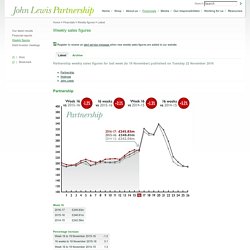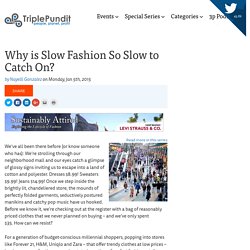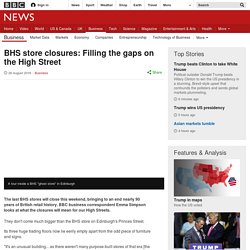

With or Without Brexit, Next PLC Is Struggling to Stay in Fashion. John Lewis Partnership - Latest. Register to receive an alert service message when new weekly sales figures are added to our website.

Partnership weekly sales figures for last week (to 19 November) published on Tuesday 22 November 2016 Managing Director: Rob Collins Retail Director: Ben Stimson Total divisional sales, excluding fuel, were in line with last year (+0.0%). Trendy Now, Trash Tomorrow. A pop up store opened by Greenpeace in Hong Kong gives away used clothes to the public for free, demonstrating shopping alternatives like swapping and second hand.

Being a fashion victim used to be cute. It’s not anymore, because our textile waste is slowly killing the planet. In a bold move to tackle the throwaway-culture in our contemporary consumer society, Sweden’s ruling Socialist Democrats and Green Party coalition has announced its plans to reduce taxes on the repair of clothes and other items to promote on-going use over time. The low cost of fast fashion has made the costs for repairing and mending comparatively too high, encouraging people to treat their clothes as disposable items and throw them away, instead of valuing and looking after them. A 2015 survey by Greenpeace Germany showed that even though people have clothes in abundance, when seams and heels break they prefer to buy new stuff instead of getting it repaired, because it´s cheap and easy. Why is Slow Fashion So Slow to Catch On? We’ve all been there before (or know someone who has): We’re strolling through our neighborhood mall and our eyes catch a glimpse of glossy signs inviting us to escape into a land of cotton and polyester.

Dresses $8.99! Sweaters $9.99! Jeans $14.99! Once we step inside the brightly lit, chandeliered store, the mounds of perfectly folded garments, seductively postured manikins and catchy pop music have us hooked. Before we know it, we’re checking out at the register with a bag of reasonably priced clothes that we never planned on buying – and we’ve only spent $35. For a generation of budget-conscious millennial shoppers, popping into stores like Forever 21, H&M, Uniqlo and Zara – that offer trendy clothes at low prices – has become par for the course. The realized growth in the fast fashion market has been astounding – and it’s leaving conventional apparel retailers in the dust. Queue in the slow fashion movement. Forbes Welcome. Retailers launch campaign to keep old clothes out of landfill. Britons are being urged to extend the life of their clothing to avoid 350,000 tonnes of garments worth an estimated £140m ending up in landfill.

High street fashion outlets including Tesco, M&S and Next, fashion designer Stella McCartney, recyclers and charities have joined forces to pledge a 15% reduction in carbon, water and waste going to landfill by 2020. In the tradition of the wartime Make Do and Mend campaign, the Love Your Clothes campaign will open up consumers' wardrobes to see what is lurking in them and how people can extend the life of their clothes, save money and keep them out of landfill.
The campaign's research showed that British households were hanging on to £30bn worth of clothes which have not been worn in the last year, while 350,000 tonnes of clothing worth £140m is binned annually. The average UK household owns around £4,000 worth of clothing and buys around £1,700 of clothes each year. 6 Reasons the British High Street Is Struggling. LONDON, United Kingdom —Earlier this month, Marks and Spencer, the UK’s largest clothing retailer, recorded a 5.8 percent drop in sales of general merchandise (which includes clothing) for the quarter including Christmas, prompting chief executive Marc Bolland to resign.

Next, the UK’s second-largest clothing retailer, also fell short: full-price sales grew a meagre 0.4 percent for the two months ending 24 December, missing estimates by more than 5 percent. Both blamed the UK’s unusually mild winter, which stalled demand for seasonal clothing (M&S, in particular, has high shares in winter categories like knitwear and coats). But this excuse has its limits. Some retailers successfully navigated the weather: Bernadette Kissane, apparel and footwear analyst at Euromonitor, points out that Debenhams “reacted to lessons learned” from 2014’s unusually warm Autumn, and limited its orders of winter stock, avoiding unsold merchandise and heavy discounting. 1. Ft. BHS store closures: Filling the gaps on the High Street. The last BHS stores will close this weekend, bringing to an end nearly 90 years of British retail history.

BBC business correspondent Emma Simpson looks at what the closures will mean for our High Streets. They don't come much bigger than the BHS store on Edinburgh's Princes Street. Its three huge trading floors now lie eerily empty apart from the odd piece of furniture and signs. "It's an unusual building... as there weren't many purpose-built stores of that era [the 1960s]. A lot of what you can see was put here in the 1960s and that's very unusual - even the escalators [and] the lifts date back to that period," says Steve Spray from LaSalle Investment Management.